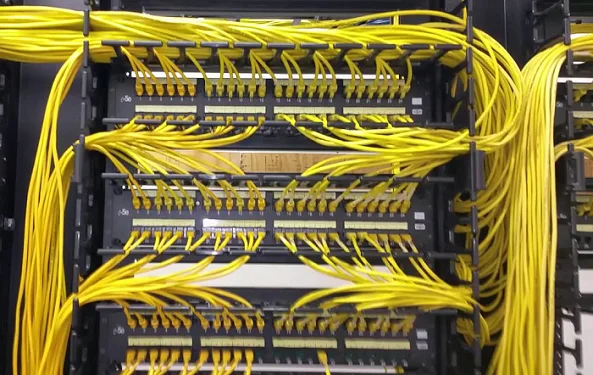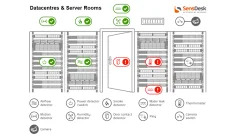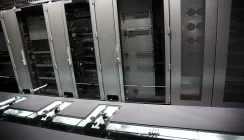A Design Checklist for IT Network Closets to Solve Power and Cooling problems
Edge computing coupled with 5G mobile wireless technology promises to be the next stage in the 5th industrial revolution and to provide the bridge to many new services, some of which are still ideas in their nascent stage of ‘if I had an App for this…’
Industry 4.0 and the Internet of Things (IoT) is already leading to a greater connectivity of devices and the sharing of their data for analysis by advanced algorithms and artificial intelligence. Industry 5.0 is now upon us and refers to people working alongside robots and smart machines and how to increase human efficiency and productivity.
We are already developing new ways to work and think, live and go about our daily tasks. The pace of change is now so rapid that it has become ‘accepted’ that today’s new iPhone 11 from Apple will be out of date next year. The pace of development of Amazon’s Alexa as a platform also demonstrates the rapidity with which new technology is adopted and can change how we live. At the start of the year over 100million Alexa devices had shipped and there were over 150 connected applications. This has more than likely doubled within the year.
Whether you have an Apple phone, Amazon Alexa, Kindle or a Google Android powered phone or tablet, what lies behind them and the latest developments in technology is an IT connectivity and data path that is connecting more and more devices, whether for streaming, data gathering or decision making. This ‘connectivity’ path runs from hyperscale datacentres through Edge computing micro data centres, to server rooms, comms rooms and IT network closets right down to the mobile compute devices we carry with us. Whatever the scale of these ‘rooms’ they are all linked by the need for well planned, installed and maintained critical infrastructure systems for power, cooling, networking and security.
IT Space and Room Definitions
In order to provide IT services and connectivity most organisations have an area within their building to house network infrastructure of some sort:
- Computer Rooms: the term is often used in schools and colleges and on university campuses to describe a central workplace in which computer and broadband or fibre connectivity points are available. Another term that is interchangeable with computer room is ‘computer lab’. The area is supposed to be one for study and work and is most often a ‘drop-in’ area and trending towards that offered in some business and offices for mobile staff. Deloitte reported that around 10million workers in the UK worked mobile i.e. using smart mobile communications and it is not beyond the imagination to think that this type of work arrangement will increase with the role out of 5G and Edge computing. A computer room will need to be connected to an IT network closet or server room if it does not have immediate network connectivity i.e. a broadband router nearby to connect to.
- IT Network Closets: this can be a small room, cupboard or closet that an organisation uses to concentrate the necessary critical infrastructure required to provide IT related services to the building users. Small companies for example choose a space into which to put their IT server, UPS system and networking devices, with or without provision for cooling. IT closets are often limited in terms of expansion room but may be the only choice available for an organisation due to space limitations including start-ups, service providers, retailers and website online shops. One of the dangers for a network closet is that it often becomes used for general storage and is not monitored for access control or temperature.
- Server Rooms: this is more of a defined space for IT critical infrastructure and one that has been designed specifically for this purpose rather than requisitioned. Server rooms have become the principle area IT and critical infrastructure concentration points for many organisations who run their own facilities on site as part of their general operations and functions. The server room is a secure and manage environment, (principally power and cooling) within a general building. Server rooms outnumber datacentres by a factor of around 500 to 1 in most countries and the number could actually increase with Edge computing as organisations continue to deploy their own IT structures rather than be fully reliant on a hyperscale datacentre.
- Datacentres: or data centres as they are also referred to are buildings specifically built to provide a secure and managed environment for server rooms. They are a complete facility dedicated to providing the environment required for IT services, built-to an Uptime Institute Tier-rating level for resilience and often with a measured energy efficiency metric such as Power Usage Effectiveness (PUE). It is important to remember that datacentres can also be built-into shipping-type containers which are referred to as mobile datacentres or modular datacentres. The modular approach is favoured by datacentre operators such as Amazon as the approach allows for a standardised design that can easily be rolled out for fast scale-up and deployed anywhere in the world it is required. Examples of hyperscale datacentre providers include Amazon AWS, Google Cloud and Microsoft Azure but there are number of others who provide co-location (Colo) type services. Where an organisation has their own datacentre for their own use, this is referred to as an ‘Enterprise’ datacentre.
- Micro Data Centres: are a relatively new concept and seek to make it easy to deploy a datacentre or server room as a ‘solution in a box’. A micro data centre or MDC contains a fully deployable IT environment with servers, connectivity, power, cooling and monitoring. The smallest micro data centre currently available is from Schneider at 6U high as part of their EcoStruxure range.
More info on mobile workers in the UK:
https://www2.deloitte.com/uk/en/pages/press-releases/articles/more-than-10-million-uk-workers-could-be-using-smartphones-to-boost-productivity.html
As the above list shows there are several ways an organisation can provide an IT facility to its users. The role out of 5G and Edge computing will lead to increased investment in critical infrastructures onsite even if an organisation uses a Cloud or hybrid Cloud arrangement. The IT hardware may shrink in size but will have higher power and cooling demands due to increased microprocessor capabilities.
If you have a computer room, server room or IT network closet the following checklist can be used to review your current arrangements and prepare for 5G and Edge computing.
IT Network Closet Room Design Checklist
- Cooling: the greater the number of severs, the greater the heat output derived from their onboard microprocessors. The room will require some form of cooling to prevent dangerously high heat levels. In a network closet this means installing a wall mount air conditioning unit, even if the server is floor standing or on a shelf to maintain an ideal ambient of 20-25˚C.
- Temperature Monitoring: even with an air conditioning unit in place, it is important to monitor and measure the temperature. The AC unit may be networked via an IP address for remote alarms but a separate room environmental monitoring solution should be installed that can take measures from multiple sensor points.
- Server Racks: rack cabinets provide an easy way to arrange servers and their associated IT and even UPS systems. They are designed for the vertical scaling of appropriately sized devices. The standard width is 19inches and cabinet depths can run from 500 to 1000mm deep. Where a server rack is used, environmental monitoring monitor multiple points in the rack to prevent ‘hot-spots’.
- Power: the provision of electrical supplies is one aspect. Most server racks are installed with a power distribution unit (PDU) to provide multiple AC outlet connections/ The PDU may be run from a local sub-distribution box (UPS protected) or from the output of an uninterruptible power supply. The UPS system provides battery backup and will keep the IT running during momentary power outages and provide sufficient battery power for an automated shutdown if there is a prolonged power outage.
- Cable Management: with any IT network it is important to adopt a structured cabling arrangement. Within a server rack, labelling and cable management can prevent accidental disconnection and more easily allow equipment to be installed or disconnected.
- Fire Suppression: depending on the room size, it may only be necessary to connect a fire/smoke monitor to the environment monitoring system or the building fire alarm panel. For large high-power density server racks (from 5-15kW) it may be necessary to install some form of automated fire suppression system.
- Security: security in datacentres is a fundamental and may include CCTV, biometrics, access control and secure turnstile systems. Sever rooms generally have access control and perhaps some form of IP camera provision. It is possible to also link server cabinet locks to access control systems and this should also be considered best practice when it comes to IT network closets. A lock and key to a closet may seem secure but cannot be automatically managed as it could be from an access control system which would also monitor usage and door activity.
Summary
The way organisations and businesses use their IT systems continues to evolve. As new services are adopted such as 5G and Edge, industry 4.0 and 5.0, there is the need to review security arrangements, whether as part of ISO27001, disaster recovery, business continuity or purely growth and expansion plans. The security does not just refer to buildings and assets but power and cooling, without which an IT system can quickly fail and disruption how an organisation or business deliveries its products and services.


























